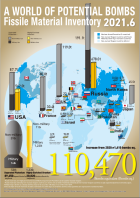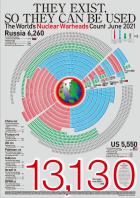RECNA Newsletter Vol.10 No.1 (September 30, 2021)
NEWSNEWS
“A Guide to the World’s Fissile Material Inventory June 2021” was released. Please click on the thumbnail images below and download the pdf guide and poster.

|
Guide to the World’s |

|
|
How to make leaflets:
Print the English Guide (PDF) for making leaflets on both sides of A3 paper, and fold it in two then in three.
|
>> Previous edtions can be downloaded from here.
Since 2015, RECNA has been compiling data on Fissile Material around the world and updating it on an annual basis. Now you can see the latest versions of “Global Inventory of Highly Enriched Uranium” and “Global Inventory of Separated Plutonium.”
See also: World’s Fissile Material Data
Since 2013, RECNA has been compiling data on nuclear warheads around the world and updating it on an annual basis. Now you can see the “Global List of Nuclear Warheads” and detailed data on “Each Country’s Nuclear Weapons Capability” updated on June 1, 2021 from here. (Past version: 2013-2017 in Japanese only; 2018-2020)
See also: World’s Nuclear Warhead Data
“A Guide to the World’s Nuclear Warheads Count June 2021” was released. Please click on the thumbnail images below and download the pdf guide and poster.

|
English Guide to the Worldʼs |

|
|
How to make leaflets:
Print the English Guide (PDF) for making leaflets on both sides of A3 paper, and fold it in two then in three.
|
>> Previous editions can be downloaded from here.